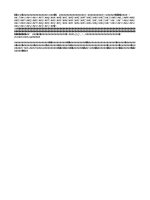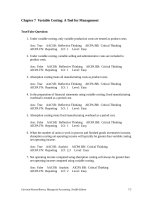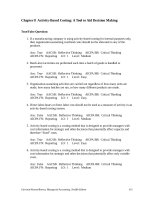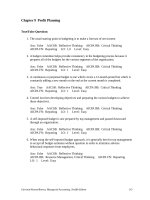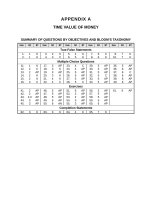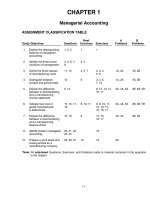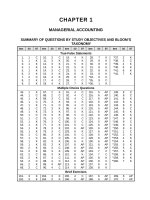Test bank managerial accounting by kieso weygandt 5e ch011
Bạn đang xem bản rút gọn của tài liệu. Xem và tải ngay bản đầy đủ của tài liệu tại đây (151.17 KB, 28 trang )
CHAPTER 11
Standard Costs and Balanced Scorecard
ASSIGNMENT CLASSIFICATION TABLE
Brief
Study Objectives
A
Questions
Exercises
Exercises
1. Distinguish between a
standard and a budget.
1, 2
1
2. Identify the advantages
of standard costs.
3
3. Describe how companies
set standards.
4, 5, 6, 7,
8, 9
2, 3
1, 2, 3, 4,
16, 18
4. State the formulas for
determining direct
materials and direct
labor variances.
10, 11
4, 5
5. State the formula for
determining the total
manufacturing overhead
variance.
12
6
6. Discuss the reporting
of variances.
B
Problems
Problems
4, 5, 6, 7,
8, 9, 12,
13, 18
1A, 2A, 3A,
4A, 5A, 6A
1B, 2B, 3B,
4B, 5B, 6B
10, 11, 18
1A, 2A, 3A,
4A, 5A, 6A
1B, 2B, 3B,
4B, 5B, 6B
13, 14
9, 13, 14
3A
3B
7. Prepare an income
statement for management
under a standard costing
system.
18
15
2A, 5A, 6A
2B, 5B, 6B
8. Describe the balanced
scorecard approach to
performance evaluation.
15, 16, 17
7
16
*9. Identify the features of a
standard cost accounting
system.
19
8, 9
17, 18, 19
6A
6B
20, 21, 22,
23
10, 11
20, 21, 22
7A, 8A, 9A,
10A
7B, 8B, 9B,
10B
*10. Compute overhead
controllable and volume
variances.
1
1
11-1
ASSIGNMENT CHARACTERISTICS TABLE
Problem
Number
Description
Difficulty
Level
Time
Allotted (min.)
1A
Compute variances.
Simple
20–30
2A
Compute variances, and prepare income statement.
Simple
30–40
3A
Compute and identify significant variances.
Moderate
20–30
4A
Answer questions about variances.
Complex
30–40
5A
Compute variances, prepare an income statement, and
explain unfavorable variances.
Moderate
30–40
*6A
Journalize and post standard cost entries, and prepare
income statement.
Moderate
40–50
*7A
Compute overhead controllable and volume variances.
Simple
10–15
*8A
Compute overhead controllable and volume variances.
Simple
10–15
*9A
Compute overhead controllable and volume variances.
Moderate
10–15
*10A
Compute overhead controllable and volume variances.
Moderate
10–15
1B
Compute variances.
Simple
20–30
2B
Compute variances, and prepare income statement.
Simple
30–40
3B
Compute and identify significant variances.
Moderate
30–40
4B
Answer questions about variances.
Complex
30–40
5B
Compute variances, prepare an income statement, and
explain unfavorable variances.
Moderate
30–40
*6B
Journalize and post standard cost entries, and prepare
income statement.
Moderate
40–50
*7B
Compute overhead controllable and volume variances.
Simple
10–15
*8B
Compute overhead controllable and volume variances.
Simple
10–15
*9B
Compute overhead controllable and volume variances.
Moderate
10–15
*10B
Compute overhead controllable and volume variances.
Moderate
10–15
11-2
11-3
Describe how companies
set standards.
State the formulas for
determining direct
materials and direct
labor variances.
State the formula for
determining the total
manufacturing overhead
variance.
Discuss the reporting of
variances.
Prepare an income statement
for management under a
standard costing system.
Describe the balanced
scorecard approach to
performance evaluation.
Identify the features of a
standard cost accounting
system.
3.
4.
5.
6.
7.
8.
*9.
Broadening Your Perspective
Compute overhead
controllable and
volume variances.
Identify the advantages of
standard costs.
2.
*10.
Distinguish between a
standard and a budget.
1.
Study Objective
Q11-10
Q11-11
Q11-8
Q11-3
P11-1A
P11-2A
P11-5A
P11-6A
E11-9
E11-12
E11-13
P11-1A
P11-2A
P11-5A
P11-6B
P11-6B
E11-14
P11-1B
P11-2B
P11-5B
P11-6B
P11-6A
P11-1B
P11-2B
P11-5B
P11-6B
E11-18
P11-3A
P11-3B
E11-10 P11-4A
E11-11 P11-3B
E11-18 P11-4B
P11-3A
E11-8
E11-18
P11-3A
P11-4A
P11-3B
P11-4B
Analysis
BE11-10 P11-7A P11-8B E11-20
BE11-11 P11-8A P11-9B E11-21
E11-20 P11-9A P11-10B E11-22
E11-21 P11-10A
E11-22 P11-7B
BE11-8 E11-18
BE11-9 E11-19
E11-17 P11-6A
BE11-7
E11-16
E11-15 P11-6A
P11-2A P11-2B
P11-5A P11-5B
E11-9
E11-13
BE11-6
E11-10
E11-11
E11-18
BE11-4
BE11-5
E11-4
E11-5
E11-6
E11-7
E11-16
Application
Q11-7 BE11-2 E11-2
Q11-9 BE11-3 E11-3
E11-18 E11-1 E11-4
E11-1
BE11-1
E11-1
Communication Managerial Analysis
Exploring the
Web
Q11-20
Q11-21
Q11-22
Q11-23
Q11-19
Q11-15
Q11-16
Q11-17
Q11-18
Q11-13
Q11-14
Q11-12
Q11-14
Q11-4
Q11-5
Q11-6
Q11-1
Q11-2
Knowledge Comprehension
Synthesis
Decision Making
Across the
Organization
Ethics Case
Real-World Focus
All About You
Evaluation
Correlation Chart between Bloom’s Taxonomy, Study Objectives and End-of-Chapter Exercises and Problems
BLOOM’S TAXONOMY TABLE
STUDY OBJECTIVES
1. DISTINGUISH BETWEEN A STANDARD AND A
BUDGET.
2. IDENTIFY THE ADVANTAGES OF STANDARD COSTS.
3. DESCRIBE HOW COMPANIES SET STANDARDS.
4. STATE THE FORMULAS FOR DETERMINING DIRECT
MATERIALS AND DIRECT LABOR VARIANCES.
5. STATE THE FORMULA FOR DETERMINING THE TOTAL
MANUFACTURING OVERHEAD VARIANCE.
6. DISCUSS THE REPORTING OF VARIANCES.
7. PREPARE AN INCOME STATEMENT FOR MANAGEMENT UNDER A STANDARD COSTING SYSTEM.
8. DESCRIBE THE BALANCED SCORECARD APPROACH
TO PERFORMANCE EVALUATION.
*9. IDENTIFY THE FEATURES OF A STANDARD COST
ACCOUNTING SYSTEM.
*10. COMPUTE OVERHEAD CONTROLLABLE AND VOLUME
VARIANCES.
11-4
CHAPTER REVIEW
Standards and Budgets
1.
(S.O. 1) In concept, standards and budgets are essentially the same. Both are predetermined
costs and both contribute significantly to management planning and control.
a. A standard is a unit amount, whereas a budget is a total amount.
b. Standard costs may be incorporated into a cost accounting system.
Why Standard Costs?
2.
(S.O. 2) Standard costs offer the following advantages to an organization:
a. They facilitate management planning.
b. They promote greater economy by making employees more “cost conscious.”
c. They are useful in setting selling prices.
d. They contribute to management control by providing a basis for the evaluation of cost
control.
e. They are useful in highlighting variances in management by exception.
f.
They simplify the costing of inventories and reduce clerical costs.
Setting Standard Costs
3.
(S.O. 3) Setting standards requires input from all persons who have responsibility for costs and
quantities. Standards may be set at one of two levels. Ideal standards represent optimum levels
of performance under perfect operating conditions. Normal standards represent efficient levels of
performance that are attainable under expected operating conditions.
4.
To establish the standard cost of producing a product, it is necessary to establish standards for
each manufacturing cost element—direct materials, direct labor, and manufacturing overhead.
The standard for each element is derived from a consideration of the standard price to be paid
and the standard quantity to be used.
Direct Materials
5.
The direct materials price standard is the cost per unit of direct materials that should be
incurred.
a. This standard is based on the purchasing departments best estimate of the cost of raw
materials.
b. This standard should include an amount for related costs such as receiving, storing, and
handling.
6.
The direct materials quantity standard is the quantity of direct materials that should be used
per unit of finished goods.
a. This standard is expressed as a physical measure, such as pounds, barrels, or board feet.
b. This standard should include allowances of unavoidable waste and normal storage.
7.
The standard direct materials cost per unit is the standard direct materials price times the
standard direct materials quantity.
11-5
Direct Labor
8.
The direct labor price standard is the rate per hour that should be incurred for direct labor.
a. This standard is based on current wage rates adjusted for anticipated changes, such as cost
of living adjustments included in many union contracts.
b. This standard generally includes employer payroll taxes and fringe benefits.
9.
The direct labor quantity standard is the time that should be required to make one unit of the
product.
a. This standard is especially critical in labor-intensive companies.
b. In setting this standard, allowances should be made for rest periods, cleanup, machine setup
and machine downtime.
10.
The standard direct labor cost per unit is the standard direct labor rate times the standard
direct labor hours.
Manufacturing Overhead
11.
The manufacturing overhead standard is based on a standard predetermined overhead rate.
a. This overhead rate is determined by dividing budgeted overhead costs by an expected
standard activity index.
b. The standard manufacturing overhead rate per unit is the predetermined overhead rate
times the activity index quantity standard.
Variances
12.
A variance is the difference between total actual costs and total standard costs. An unfavorable
variance suggests that too much was paid for materials, labor, and manufacturing overhead or
that there were inefficiencies in using materials, labor, and manufacturing overhead. Favorable
variances indicate efficiencies in incurring costs and in using materials, labor, and manufacturing
overhead.
13.
Analyzing variances begins with a determination of the cost elements that comprise the
variance. For each manufacturing cost element, a total dollar variance is computed. Then this
variance is analyzed into a price variance and a quantity variance.
Direct Materials Variances
14.
(S.O. 4) The formulas for the direct materials variances are:
Actual Quantity
X Actual Price
(AQ) X (AP)
–
Standard Quantity
X Standard Price
(SQ) X (SP)
=
Total Materials
Variance
(TMV)
Actual Quantity
X Actual Price
(AQ) X (AP)
–
Actual Quantity
X Standard Price
(AQ) X (SP)
=
Materials Price
Variance
(MPV)
Actual Quantity
X Standard Price
(AQ) X (SP)
–
Standard Quantity
X Standard Price
(SQ) X (SP)
=
Materials
Quantity Variance
(MQV)
11-6
15.
A variance matrix can be used in analyzing variances. In such cases, the formulas for each cost
element are computed first and then the variances.
16.
Materials price variances are usually the responsibility of the purchasing department, whereas
materials quantity variances are usually attributable to the production department.
Direct Labor Variances
17.
18.
The formulas for the direct labor variances are:
Actual Hours
X Actual Rate
(AH) X (AR)
–
Standard Hours
X Standard Rate
(SH) X (SR)
=
Total Labor
Variance
(TLV)
Actual Hours
X Actual Rate
(AH) X (AR)
–
Actual Hours
X Standard Rate
(AH) X (SR)
=
Labor Price
Variance
(LPV)
Actual Hours
X Standard Rate
(AH) X (SR)
–
Standard Hours
X Standard Rate
(SH) X (SR)
=
Labor Quantity
Variance
(LQV)
Labor price variances usually result from paying workers higher wages than expected and/or
misallocation of workers. Labor quantity variances relate to the efficiency of the workers and are
the responsibility of the production department.
Manufacturing Overhead Variances
19.
(S.O. 5) The total overhead variance is the difference between the actual overhead costs and
overhead costs applied based on standard hours allowed.
20.
To find the total overhead variance in a standard costing system, we determine the overhead
costs applied based on standard hours allowed. Standard hours allowed are the hours that
should have been worked for the units produced. The total overhead variance formula is as
follows:
Actual
Overhead
21.
–
Overhead
Applied
=
Total Overhead
Variance
One reason for an overhead variance relates to over- or under-spending on overhead items.
Generally the responsibility for these variances rests with the production department. The
overhead variance can also result from inefficient use of overhead. The responsibility for these
variances rests on either the production or sales departments.
Reporting of Variances
22.
(S.O. 6) All variances should be reported to appropriate levels of management as soon as
possible. Variance reports facilitate the principle of “management by exception.” Rather than
analyze every variance, top management will normally look for significant variances.
11-7
Statement Presentation of Variances
23. (S.O. 7) In income statements prepared for management under a standard cost accounting
system, cost of goods sold is stated at standard cost and the variances are separately disclosed.
In financial statements prepared for stockholders and other external users, standard costs may be
used.
Balanced Scorecard
24. (S.O. 8) Many companies use both financial and nonfinancial measures to evaluate performance.
This approach is known as the balanced scorecard. The four most commonly employed
perspectives are as follows:
a.
The financial perspective employs financial measures of performance.
b.
The customer perspective evaluates how well the company is performing from the
viewpoint of those people who buy and use its product.
c.
The internal process perspective evaluates the internal operating processes critical to
success.
d.
The earning and growth perspective evaluates how well the company develops and
retains its employees.
The different perspectives are linked together so a company can better understand how to achieve its
goals and what measures to use to evaluate performance.
Standard Cost Accounting System
*25. (S.O. 9) A standard cost accounting system is a double-entry system of accounting in which
standard costs are used in making entries and variances are formally recognized in the accounts.
A standard cost system may be used with either job order or process costing.
*26. As an example, the purchase of raw materials inventory for $5,000 when the standard cost is
$6,000 would be recorded as follows:
Raw Materials Inventory.......................................................................
Materials Price Variance..............................................................
Accounts Payable..........................................................................
a.
b.
6,000
1,000
5,000
A debit balance in a variance account indicates an unfavorable variance.
A credit balance in a variance account indicates a favorable variance.
*27. In income statements prepared for management, cost of goods sold is stated at standard cost and
the variances are separately disclosed.
*28. Standard costs may be used in costing inventories in financial statements prepared for
stockholders when there are no significant differences between actual and standard costs.
However, if the difference is material, the inventories and cost of goods sold must be reported at
actual costs.
11-8
Overhead Variances
*29. (S.O. 10) The computation of the manufacturing overhead variances is conceptually the same
as the computation of the materials and labor variances. For manufacturing overhead, however,
both variable and fixed overhead must be considered. The formulas are:
Actual
Overhead
–
Overhead
Applied*
=
Actual
Overhead
–
Overhead
Budgeted*
=
Fixed
Overhead
Rate
X
(
Normal
Standard
Capacity – Hours
Hours
Allowed
)
Total Overhead
Variance
Overhead
Controllable
Variance
=
Overhead
Volume
Variance
*30. The overhead controllable variance shows whether overhead costs were effectively controlled.
a. Budgeted costs are determined from the flexible manufacturing overhead budget for
standard hours allowed.
b. Most controllable variances are associated with variable costs which are controllable costs.
*31. The overhead volume variance indicates whether plant facilities were efficiently used during the
period.
a. This variance relates solely to fixed costs.
b. It measures the amount that fixed overhead costs are under- or overapplied.
*32. In computing the overhead variances,
a. Standard hours allowed are used in each of the variances.
b. Budgeted costs are derived from the flexible budget.
c. The controllable variance generally pertains to variable costs.
d. The volume variance pertains solely to fixed costs.
11-9
LECTURE OUTLINE
A.
The Need for Standards.
1. Standards are common in business; those imposed by government
agencies are often called regulations.
2. Both standards and budgets are predetermined costs, and both contribute
to management planning and control.
a.
A standard is a unit amount.
b.
A budget is a total amount.
3. A standard is the budgeted cost per unit of product.
4. Standard costs offer a number of advantages to an organization:
B.
a.
They facilitate management planning.
b.
They promote greater economy by making employees more
“cost-conscious.”
c.
They are useful in setting selling prices.
d.
They contribute to management control by providing a basis for
evaluation of cost control.
e.
They are useful in highlighting variances in management by exception.
f.
They simplify costing of inventories and reduce clerical costs.
Setting Standard Costs.
1. Companies set standards at one of two levels:
a.
Ideal, or
b.
Normal.
11-10
2. Ideal standards represent optimum levels of performance under perfect
operating conditions.
3. Normal standards represent efficient levels of performance that are attainable under expected operating conditions.
4. Most companies that use standards set them at a normal level. Properly
set, normal standards should be rigorous but attainable.
TEACHING TIP
Use ILLUSTRATION 11-1 to discuss the development of standard cost per unit of
product. Emphasize that the standard cost for each product cost element consists
of a quantity factor and a price factor.
5. The direct materials price standard should be based on the delivered
cost of raw materials plus an allowance for receiving and handling.
6. The direct materials quantity standard should establish the required
quantity plus an allowance for unavoidable waste and normal spoilage.
7. The direct labor price standard should be based on current wage rates
and anticipated adjustments such as cost of living adjustments (COLAs).
8. The direct labor quantity standard should be based on required production
time plus an allowance for rest periods, cleanup, machine setup, and
machine downtime.
a.
This standard, also called the direct labor efficiency standard, is
especially critical in labor-intensive companies.
9. For manufacturing overhead, a standard predetermined overhead rate is
used. It is based on an expected standard activity index such as standard
direct labor hours or standard machine hours.
11-11
10. The total standard cost per unit is the sum of the standard costs of direct
materials, direct labor, and manufacturing overhead.
C.
Analyzing and Reporting Variances from Standards.
1. One of the major management uses of standard costs is to identify
variances from standards. Variances are the differences between total
actual costs and total standard costs.
a.
Variances are expressed in total dollars and not on a per unit basis.
b.
When actual costs exceed standard costs, the variance is unfavorable.
c.
If actual costs are less than standard costs, the variance is favorable.
2. Direct materials variances.
TEACHING TIP
ILLUSTRATION 11-2 provides formulas for computing total materials variance,
materials price variance, and materials quantity variance.
a.
(Actual Quantity × Actual Price) – (Standard Quantity × Standard
Price) = Total Materials Variance (TMV).
b.
(Actual Quantity × Actual Price) – (Actual Quantity × Standard
Price) = Materials Price Variance (MPV).
c.
(Actual Quantity × Standard Price) – (Standard Quantity × Standard
Price) = Materials Quantity Variance (MQV).
11-12
3. Causes of materials variances.
The investigation of a materials price variance usually begins in the purchasing department. The starting point for determining the cause(s) of an
unfavorable materials quantity variance is in the production department.
TEACHING TIP
Use ILLUSTRATION 11-3 to demonstrate the calculation of the materials variances
by means of a matrix. Journal entries are illustrated that incorporate standard
costs into the accounts in the general ledger.
4. Direct labor variances.
TEACHING TIP
ILLUSTRATION 11-4 provides formulas for computing total direct labor variance,
labor price variance, and labor quantity variance.
a.
(Actual Hours × Actual Rate) – (Standard Hours × Standard Rate) =
Total Labor Variance (TLV).
b.
(Actual Hours × Actual Rate) – (Actual Hours × Standard Rate) =
Labor Price Variance (LPV).
c.
(Actual Hours × Standard Rate) – (Standard Hours × Standard
Rate) = Labor Quantity Variance (LQV).
5. Causes of labor variances.
a.
Labor price variances usually result from two factors:
(1) Paying workers higher wages than expected,
(2) Misallocation of workers.
11-13
b.
Labor quantity variances relate to the efficiency of workers and
generally can be traced to the production department.
TEACHING TIP
Use ILLUSTRATION 11-5 to demonstrate the calculation of the direct labor
variances by means of a matrix. Journal entries are illustrated that incorporate
standard costs into the accounts in the general ledger.
6. Manufacturing overhead variance.
a.
Actual Overhead – Overhead Applied = Total Overhead Variance.
(Overhead applied is based on standard hours allowed).
7. Causes of manufacturing overhead variance.
Responsibility for the overhead variance rests with the production
department. The cause of the variance may be:
a.
Higher than expected use of indirect materials, indirect labor, and
electricity, or
b.
Inefficient use of overhead (i.e. reduced production due to machine
breakdowns because of poor maintenance).
8. The overhead variance is the responsibility of the production department
if the cause is lack of skilled labor or machine breakdowns. When the
cause is a lack of sales orders, the responsibility rests outside the
production department.
D.
Reporting Variances.
1. All variances should be reported to appropriate levels of management as
soon as possible.
11-14
2. Variance reports facilitate the principle of “management by exception” by
highlighting significant differences.
3. Top management normally looks for significant variances. These may be
judged on the basis of some quantitative measure, such as more than
10% of the standard or more than $1,000.
E.
Statement Presentation of Variances.
1. In income statements prepared for management under a standard cost
accounting system, cost of goods sold is stated at standard cost and the
variances are disclosed separately.
2. When there are no significant differences between actual costs and
standard costs, companies report their inventories at standard costs.
3. If there are significant differences between actual and standard costs,
the financial statements must report inventories and cost of goods sold
at actual costs.
F.
Balanced Scorecard.
1. The balanced scorecard incorporates financial and nonfinancial measures
in an integrated system that links performance measurement and a
companys strategic goals.
2. The balanced scorecard evaluates company performance from four
perspectives:
a.
Financial perspective—employs financial measures of performance
used by most firms.
b.
Customer perspective—evaluates how well the company is performing from the viewpoint of those people who buy and use its
products or services.
11-15
c.
Internal process perspective—evaluates the internal operating processes critical to success.
d.
Learning and growth perspective—evaluates how well the company
develops and retains its employees.
3. Within each perspective, the balanced scorecard identifies objectives
that will contribute to attainment of strategic goals. The objectives are
linked across perspectives in order to tie performance measurement to
company goals.
4. The balanced scorecard provides measurable objectives for nonfinancial
measures such as product quality.
5. It integrates all of the companys goals into a single performance measurement system.
*G. Standard Cost Accounting System.
1. A standard cost accounting system is a double-entry system of accounting.
In this system, companies use standard costs in making entries, and
they formally recognize variances in the accounts.
2. The system is based on two important assumptions:
a.
Variances from standards are recognized at the earliest opportunity, and
b.
The Work in Process account is maintained exclusively on the basis
of standard costs.
*H. Overhead Controllable and Volume Variances.
1. The total overhead variance is generally analyzed through a price
variance (controllable variance) and a quantity variance (volume
variance).
11-16
2. The overhead controllable variance shows whether overhead costs are
effectively controlled.
3. The overhead volume variance relates to whether fixed costs were
under-or over-applied during the year.
TEACHING TIP
ILLUSTRATION 11-6 provides formulas for computing total overhead variance,
controllable variance, and volume variance.
a.
Actual Overhead – Overhead Budgeted = Overhead Controllable
Variance. (Overhead budgeted is based on standard hours allowed).
b.
Fixed Overhead Rate × [Normal Capacity Hours – Standard Hours
Allowed] = Overhead Volume Variance.
TEACHING TIP
Use ILLUSTRATION 11-7 to demonstrate the calculation of the overhead variances.
Journal entries are illustrated that incorporate standard costs into the accounts in
the general ledger. See Illustration 11-1 in which predetermined variable and
fixed overhead rates per unit are computed as shown on the job cost sheet.
11-17
20 MINUTE QUIZ
Circle the correct answer.
True/False
1. The primary difference between standards and budgets is that a standard is a unit
amount, whereas a budget is a total amount.
True
False
2. An advantage of standard costs is that standard costs facilitate management planning by
establishing expected future costs.
True
False
3. Ideal standards represent an efficient level of performance that is attainable under
expected operating conditions.
True
False
4. The direct labor price standard generally includes employer payroll taxes and fringe
benefits, such as paid holidays and vacations.
True
False
5. (Actual Quantity × Standard Price) – (Standard Quantity × Actual Price) = Materials Price
Variance.
True
False
6. (Actual Hours × Actual Rate) – (Actual Hours × Standard Rate) = Labor Price Variance.
True
False
7. Standard hours allowed are the hours that should have been worked for the units produced.
True
False
8. Variance reports facilitate the principle of “management by exception.”
True
False
9. In income statements prepared under a standard cost accounting system, cost of goods
sold is stated at standard cost.
True
False
*10. The overhead controllable variance is the difference between the actual overhead costs
incurred and the overhead applied.
True
False
11-18
Multiple Choice
1.
Which of the following is an advantage of standard costs?
a. Contribution to management control.
b. Promotion of greater economy and efficiency.
c. Simplification of the costing of inventories and reduction of clerical costs.
d. All of the above.
2.
If the predetermined overhead rate per hour is $6 for variable and $2 for fixed overhead,
standard direct labor hours per unit is 2 hours and actual direct labor hours per unit was
1.5 hours, then the overhead standard per unit is
a. $4 per unit.
b. $8 per unit.
c. $16 per unit.
d. $12 per unit.
3.
The formula for the labor quantity (or efficiency) variance is
a. (Actual Hours × Actual Rate) – (Actual Hours × Standard Rate).
b. (Actual Hours × Standard Rate) – (Standard Hours × Standard Rate).
c. (Standard Hours × Actual Rate) – (Standard Hours × Standard Rate).
d. none of the above.
*4.
If actual overhead is $70,000, overhead applied is $67,000 and overhead budgeted for
the standard hours allowed is $78,000, then the overhead controllable variance is
a. $3,000 F.
b. $11,000 U.
c. $8,000 F.
d. $8,000 U.
*5.
In a standard cost accounting system, a company purchased raw materials on account
for $46,500 when the standard cost was $44,000. The journal entry would not include a
a. debit to Raw Materials Inventory for $44,000.
b. debit to Materials Price Variance for $2,500.
c. credit to Materials Price Variance for $2,500.
d. credit to Accounts Payable for $46,500.
11-19
ANSWERS TO QUIZ
True/False
1.
2.
3.
4.
5.
True
True
False
True
False
6.
7.
8.
9.
*10.
True
True
True
True
False
Multiple Choice
1.
2.
3.
*4.
*5.
d.
c.
b.
c.
c.
11-20
ILLUSTRATION 11-1
STANDARD COSTS
STANDARD COST CARD
Total Standard
Cost per Unit
Direct Materials
Quantity
2 pounds
Price
×
$5 per lb.
=
$10
=
36
=
48
$94
Direct Labor
Quantity
4 hours
Price
×
$9 per hr.
Manufacturing Overhead
Quantity
Price
4 hours
(1) $ 8 Variable
(2) 4 Fixed
$12 per hr.
×
Standard Predetermined Overhead Rate:
(1)
Budgeted Variable Overhead Cost
$ 80,000
=
Expected number of standard labor hours
10,000
=
$ 8
Budgeted Fixed Overhead Cost
$ 40,000
=
Expected number of standard labor hours
10,000
=
4
Total Budgeted Overhead Cost
= $120,000
Expected number of standard labor hours =
10,000
=
$12
(2)
11-21
ILLUSTRATION 11-2
FORMULAS FOR MATERIALS VARIANCES
FORMULA FOR TOTAL MATERIALS VARIANCE (TMV)
Actual Quantity
× Actual Price
(AQ) × (AP)
–
Standard Quantity
× Standard Price
(SQ) × (SP)
=
Total
Materials
Variance
FORMULA FOR MATERIALS PRICE VARIANCE (MPV)
Actual Quantity
× Actual Price
(AQ) × (AP)
–
Actual Quantity
× Standard Price
(AQ) × (SP)
=
Materials
Price
Variance
FORMULA FOR MATERIALS QUANTITY VARIANCE (MQV)
Actual Quantity
× Standard Price
(AQ) × (SP)
–
Standard Quantity
× Standard Price
(SQ) × (SP)
11-22
=
Materials
Quantity
Variance
ILLUSTRATION 11-3
VARIANCE ANALYSIS—DIRECT MATERIALS
Problem Standard prices for materials purchased = $5.00 per lb.
Data:
Actual quantity of materials purchased and used = 5,200 lbs.
Actual price for materials purchased = $4.80 per lb.
Actual product produced = 2,400 units
Standard quantity of materials used for products produced = 4,800 lbs.
(2,400 × 2 lbs.)
Actual Quantity
× Actual Price
Actual Quantity
× Standard Price
Standard Quantity
× Standard Price
(AQ) × (AP)
5,200 × $4.80
$24,960
(AQ) × (SP)
5,200 × $5.00
$26,000
(SQ) × (SP)
4,800 × $5.00
$24,000
Quantity Variance
$26,000 – $24,000
= $2,000 U
Price Variance
$24,960 – $26,000
= $1,040 F
Total Variance
$24,960 – $24,000
= $960 U
JOURNAL ENTRIES
Raw Materials Inventory
Materials Price Variance
Accounts Payable
(To record purchase of materials)
26,000
Work in Process Inventory
24,000
Materials Quantity Variance
2,000
Raw Materials Inventory
(To record issuance of raw materials)
11-23
1,040
24,960
26,000
ILLUSTRATION 11-4
FORMULAS FOR DIRECT LABOR VARIANCES
FORMULA FOR TOTAL LABOR VARIANCE (TLV)
Actual Hours
× Actual Rate
(AH) × (AR)
–
Standard Hours
× Standard Rate
(SH) × (SR)
=
Total
Labor
Variance
FORMULA FOR LABOR PRICE VARIANCE (LPV)
Actual Hours
× Actual Rate
(AH) × (AR)
–
Actual Hours
× Standard Rate
(AH) × (SR)
=
Labor
Price
Variance
FORMULA FOR LABOR QUANTITY VARIANCE (LQV)
Actual Hours
× Standard Rate
(AH) × (SR)
–
Standard Hours
× Standard Rate
(SH) × (SR)
11-24
=
Labor
Quantity
Variance
ILLUSTRATION 11-5
VARIANCE ANALYSIS—DIRECT LABOR
Problem Standard rate of pay = $9.00 per hour
Data:
Actual direct labor hours worked = 9,500 hours
Actual rate of pay = $9.50 per hour
Actual product produced = 2,400 units
Standard quantity of labor hours for products produced = 9,600 hrs.
(2,400 × 4 hrs.)
Actual Hours
× Actual Rate
Actual Hours
× Standard Rate
Standard Hours
× Standard Rate
(AH) × (AR)
9,500 × $9.50
$90,250
(AH) × (SR)
9,500 × $9.00
$85,500
(SH) × (SR)
9,600 × $9.00
$86,400
Quantity Variance
$85,500 – $86,400
= $900 F
Price Variance
$90,250 – $85,500
= $4,750 U
Total Variance
$90,250 – $86,400
= $3,850 U
JOURNAL ENTRIES
Factory Labor
Labor Price Variance
Wages Payable
(To record direct labor costs)
85,500
4,750
Work in Process Inventory
Labor Quantity Variance
Factory Labor
(To assign factory labor to jobs)
86,400
11-25
90,250
900
85,500
